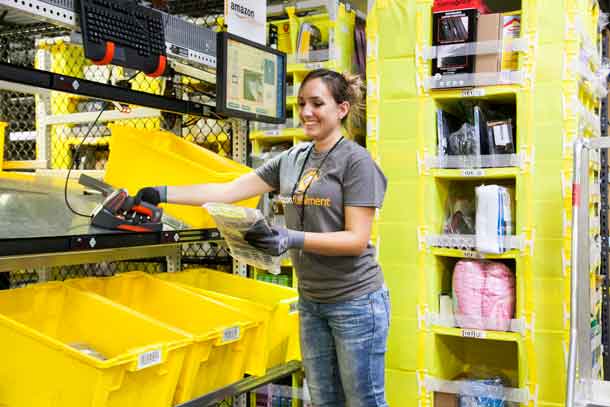
“Thousands of years ago, our grandfathers left us a clean environment free of pollution. We must maintain it this way,” he emphasized.
Armed with tools old and new – wooden spears, radios, drones, and maps created using mobile phones and GIS tools – the 26-strong Indigenous guard regularly patrols their gold-rich land.

Since 2018, Ecuador’s top court has ruled in favour of the Cofan and another indigenous group – the Waorani living in the eastern Amazon province of Pastaza – as they seek to block development projects on their land.
In both cases, judicial authorities agreed with claims by the groups that they had not been properly consulted, in advance and in full, about the planned projects, or given any real power to object to them.

In February, the Cofan celebrated a rare victory when Ecuador’s constitutional court ratified a ruling that had suspended 52 formal gold mining concessions – lasting up to 30 years – granted across 32,000 hectares (79,000 acres) of their land, saying the community was not properly consulted.
The court said Indigenous communities must give permission in advance for any major extractive projects planned in their territories or other projects that could affect their way of life.

“The ruling set a precedent,” said Jorge Acero, a lawyer with Amazon Frontlines, an advocacy group supporting the Cofan. “It can be applied to any indigenous group, and judges across the region are taking note.”
Oil riches

Ecuador produces around 500,000 barrels of crude a day, and oil income is crucial for the cash-strapped conservative government of President Guillermo Lasso. Like many oil-producing nations, Ecuador is eager to profit from rising crude prices.
Lasso, an ex-banker who took office in May 2021, issued two decrees in his first days in office meant to facilitate the development of oil blocks and attract billions of dollars in foreign investment for mining and oil projects.
The president has said he aims in the next three years to double to $4 billion annual mining exports, mostly of gold and copper, and also double crude output, much of it pumped from oil wells in the Amazon.

“We’re worried about Lasso’s decrees,” said the 30-year-old, who belongs to a six-member elected committee that makes laws and guides the Cofan community.
“Our fear is that the mining concessions will be reactivated. The government wants to extract the country’s natural resources,” he said, as children played hide-and-seek behind a mural painted with the slogan, “Our territory, our decision.”
Vanishing forest

Yet across most of the Amazon basin, which spans nine countries in South America, deforestation is surging as trees fall to agricultural expansion, oil exploration, illegal gold mining and production of coca, used to make cocaine.
In Brazil, home to the biggest share of the Amazon, 940 square kilometers (360 square miles) of rainforest was destroyed in just the first three months of this year – an area larger than New York City.
The losses, under pro-development President Jair Bolsonaro’s administration, were the largest in at least six years.

In its decision, the court recognized community laws created by the A’i Cofan, giving them the formal right to order intruders – including loggers and miners – off their land and to confiscate their equipment.

Indigenous communities like the Cofan already carrying out patrols say policing their borders has been crucial in keeping large-scale mining out of their territory and protecting the surrounding forest in one of the world’s most biodiverse ecosystems.
“If the Indigenous guard didn’t exist, and we didn’t exist, this area would now be full of pasture land and gold mines,” Guaramag said.
Footage gathered on camera traps in the forest reveals not only jaguars on the prowl at night but miners walking – evidence that has proved useful to the Cofan in court.

Alexandra Narvaez, the Cofan guard’s first woman member and a winner of the 2022 Goldman Environmental Prize, said the group has come across makeshift mining camps with heavy excavating machinery as well.
When miners are detected, a community assembly is held to decide what action to take. Usually that starts with serving an eviction notice to the intruders.
“We hold a peaceful dialogue with the miners and read out a notification ordering them to leave,” said Narvaez, 30, as she trekked through the dark and humid forest of tangled vines.
“We explain to them that this is our home, and that as a community we have said no to mining on our territory. If they don’t obey, we seize their equipment and burn it,” she said.
Most miners – small-scale operators trying their luck with rented equipment – comply, community members said.
To shore up their rights to control their land in the face of growing pressures, the Cofan hope to be awarded a collective land title – a challenge as their land lies within the Cayambe Coca national park.
Indigenous leaders presented paperwork for the title to the environment ministry in late 2021 and are waiting for approval.
“We know this territory is ours but we need a piece of paper to prove it,” said Guaramag, as indigenous youth played volleyball in the village of 300, with its two-story aluminum-roofed stilt homes, fish pools and plain evangelical church.

Research shows that forest loss is lowest in indigenous lands with secure land tenure and collective land titles, a 2021 United Nations report noted.
“Having a property title would give us greater legal security … We can better protect our territory from the outside world and from invasion,” Guaramag added.
Scam consultation

Similar legal battles have played out about 200 kilometers (125 miles) away, in a more isolated corner of Ecuador’s Amazon with little cell phone service, internet coverage or electricity.
Like the Cofan, the Waorani of Pastaza province have been fighting government plans to drill on their remote oil-rich forest land – and have won court victories.
“We’ve said no to oil. We’ve resisted against the government and extractive companies,” said Silvana Nihua, president of the Waorani Organization of Pastaza (OWAP), as the noisy mating calls of cicadas pulsated from the forest surrounding a riverside village.

“The biggest threat we face is the oil companies entering,” she said.
The settlement – reached by a narrow dirt road sliced through the forest in the 1970s during Ecuador’s oil boom and then a three-hour motorized canoe ride along the Curaray River – is home to some of the region’s 5,000 Waorani.
Their ancestral and titled land is spread across 800,000 hectares (2 million acres) of Ecuador’s Amazon, including parts of Napo, Pastaza and Orellana provinces as well as Yasuni national park.

Like the Cofan, the Waorani have said the government did not properly consult them before developing energy projects.
“We are defending our home with pen and paper and our voices, and not with spears,” said 29-year-old Nihua, who leads 30 communities of about 1,000 Pastaza Waorani people living in villages spread along the river.
A court ruled in 2019 that the Waorani of Pastaza had not been properly consulted over government plans to auction off part of their ancestral lands for oil extraction.

It banned drilling on nearly 500,000 acres (200,000 hectares) of rainforest, including 444,000 acres of Waorani territory known as Block 22. It also said any future development plans must involve a full consultation well ahead of any activity going ahead.
“We live on these lands and we want to continue to live in harmony with nature as our grandparents did,” said Nihua, wearing a crown of white, yellow and scarlet parrot feathers and with bars of red – a colour symbolizing strength and joy – painted above her cheeks.
“Our fight is that our rights are respected,” she said.
The Waorani, like other Amazon indigenous communities, are now drawing up a blueprint for what an effective consultation process should look like, based on their own culture and systems of governance.
A lack of clear laws and guidelines about how indigenous communities should participate in decisions made about what happens on their lands is often a key source of conflict between them, the government and extractive companies.
The same issue faces many indigenous communities in Ecuador and in other South American Amazon nations – from Colombia to Peru – who are fighting to preserve their culture and the rainforest from destruction.

“That was the consultation. That was the scam,” said Tone, 51, standing in the shade near a majestic old ceiba tree.
“They didn’t explain why they were there or who they were. We later learned that the list was delivered to government officials in Quito as proof we’d agreed to something we had no idea about,” he said.
Oil beggars

Speaking under a starry night sky filled with shooting stars, Nihua said the biggest challenge she faces as a leader is keeping her community united and resolute in the face of cash offered by miners and drillers, and by other outside promises of a better life.
“If we’re divided, our territory will be exploited,” she said.
Last year, the Waorani of Pastaza voted to establish community rules prohibiting any oil exploration on their lands.
Yet elsewhere in Ecuador’s Amazon other indigenous communities – including some Cofan and Waorani – have allowed drilling over the decades near and on their lands.
The Waorani are organised in small clan settlements, making it easier for drillers and miners to divide and conquer communities, Nihua said
“The oil companies speak to two or three families at a time and offer them money to get permission to enter their lands. There are always families who want to negotiate. They don’t see the life they will suffer later,” Nihua said.

Cash payments offered typically range from $2,500 to $10,000 per family, she said. She called those who accept them “traitors” and “oil beggars”.
She has seen the effect of such temptations close up.
A decade ago, lured by the prospect of getting a job and earning cash to buy things they had encountered from the outside world – from mobile phones to clothing – six of Nihua’s siblings left the community to work as trash collectors and laborers for oil companies in the Yasuni national park.
“It pains me to see them there. The first thing they do is spend all the money on alcohol,” she said.
Fast money

Fifteen years ago, in a bid to save Yasuni national park from oil development, Ecuador’s former President Rafael Correa asked wealthy countries to donate $3.6 billion to offset revenue lost by not drilling there.
The initiative brought in less than 4% of that amount so Correa dropped the plan six years later and authorized drilling, saying the world had failed Ecuador.
Today indigenous communities across Ecuador’s Amazon continue to live alongside oil wells run mostly by state oil company Petroamazonas EP.

Many are concentrated in the Amazon provinces of Napo and Orellana, home to the Waorani and other indigenous groups.
Newcomer China National Petroleum Corp (CNPC) also was awarded a contract in February to drill 40 wells at the Ishpingo oilfield near Yasuni national park.
Camilo Huamoni, who heads the umbrella organization of the Waorani – NAWE – said about 10% of its 5,500 members are in favor of mining and oil drilling.

“With oil comes a loss of identity. They come to rely on oil. People see fast money. They don’t realize money doesn’t last forever,” said Huamoni, 41, who has led NAWE for 15 years and is studying for a law degree.
A fragile culture makes it harder to stay united and ensure traditional knowledge is passed down to indigenous youth – something Nihua says is a priority as she guides her community as its elected president for the next three years.

“If we don’t take care of nature, others will destroy it. If the oil companies come in, the forest will be destroyed,” she warned.
Reporting: Anastasia Moloney
Text editing: Laurie Goering
Photography: Fabio Cuttica
Videography: Fabio Cuttica
Video editing: Jacob Templin
Graphics: Tom Finn
Producer: Amber Milne






